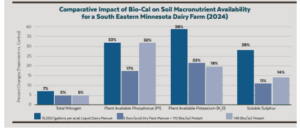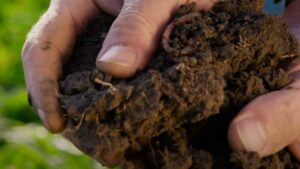Strategic Overview: Understanding the Efficacy of Bio-Cal® in Achieving Key Business Goals
Bio-Cal® is a calcium-based soil amendment designed to improve soil health and enhance crop performance. Its highly soluble formula increases the efficiency of manure application in the first year. Acting as a catalyst in soil fertility programs, Bio-Cal helps mobilize essential nutrients, unlocks the full potential of the soil, and promotes healthier plant growth throughout the season. As the first fertilizer-grade calcium in its category, Bio-Cal effectively balances soil pH, improves soil structure, and supports better root development. It is particularly beneficial for soils with low calcium levels or high concentrations of potassium or magnesium, helping to optimize farm productivity while promoting long-term soil health.
Unlocking Excellence
In 2024, we tested 10 on-farm forage and row crop trials for Bio-Cal, which included 34 experimental sites and 54 soil types. These sites included manure and dry fertilizer nutrient management systems. With a mean application rate of 500 pounds per acre Bio-Cal.
Comprehensive Methodology & Experimental Design: Ensuring Accurate Bio-Cal Results
Soil and plant tissue samples were collected at each site according to guidelines from Midwest Laboratories. Soil samples underwent two analyses: the natural ammonium acetate extraction (AAE) method and the saturated paste (SPE) method. The SPE method, commonly used in western North America, better represents the short to medium-term nutrient pool, while the AAE method reflects a long-term nutrient pool. Utilizing both soil sampling methodologies provided visibly into the mobility of soil nutrients as they are assimilated into the plant.
Key Findings and Data Insights for Optimal Performance
During our 2024 trial season, Bio-Cal demonstrated significant improvements in soil quality and nutrient availability in Southeastern Minnesota’s Multi-Year No-Till Corn/Soybean trials. Notably, Bio-Cal reduced spring soil compaction by 19% (44 PSI). This reduction was measured using penetrometer readings from EarthOptics, indicating better soil structure and root penetration.
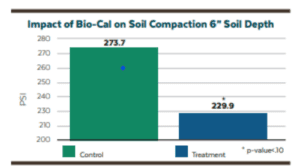
Bio-Cal also had a marked impact on sulfur availability. While total sulfur levels remained stable, the application of Bio-Cal increased both available and soluble sulfur pools by 20% and 28%, respectively. This suggests Bio-Cal is enhancing the biochemical cycling of soil sulfur, making it more accessible to plants.
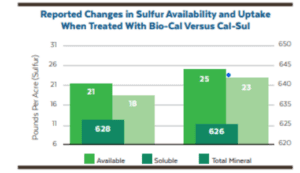
In South Central Wisconsin, Bio-Cal significantly lowered soil magnesium levels in a soil influenced by dolomitic parent material. After two years of applying Bio-Cal at 500 pounds per acre, soil magnesium dropped by 32% (equating to a reduction of 386 pounds per acre). Along with this reduction, base saturation magnesium decreased by 5.66% (from 26% to 20%), without affecting other base saturation levels.
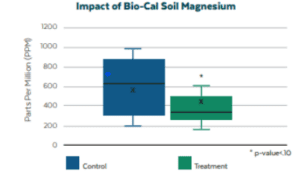
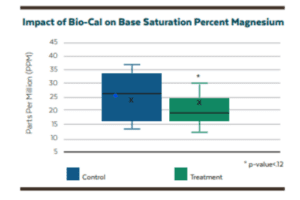
Perhaps most significantly, Bio-Cal boosted both potassium and sulfur availability in 2023-2024. In 90% of the samples collected from Bio-Cal trials, potassium availability improved substantially, with a 9% increase in soil potassium (lbs/ac) and a 10% increase in base saturation K%. This resulted in a 52 pounds per acre increase in K2O, highlighting Bio-Cal’s positive impact on nutrient cycling and overall soil fertility.
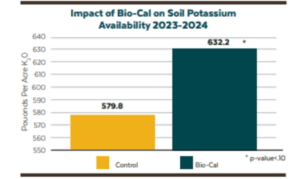
Key Takeaways and Impact of Bio-Cal Efficacy on Performance
In conclusion, the 2023-2024 Bio-Cal trials clearly demonstrate the soil amendments effectiveness in improving soil health and nutrient availability. By reducing spring soil compaction, enhancing sulfur and potassium availability, and lowering excessive magnesium levels, Bio-Cal provides valuable benefits to soil fertility programs. Its ability to optimize key nutrients—especially in soils with imbalances—helps promote healthier, more productive crops. The data from these trials reinforce Bio-Cal’s role as an essential tool for farmers looking to enhance soil structure, improve nutrient cycling, and ultimately increase farm productivity while supporting long-term soil health.
